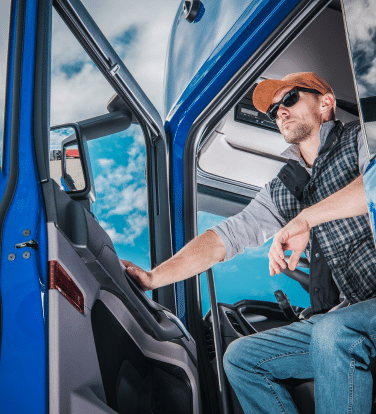
Tips for Passing Your CDL Test
Becoming a commercial truck driver is an exciting and rewarding career choice! But, before you can hit the open road, you must first pass your Commercial Driver’s Test. These tests consist of both a written knowledge test and a skills-based road test. Proper preparation is crucial to ensure success.
Here are a few tips on how you can tackle your exam with confidence:
What Does CDL Class A Training Involve and Why Is It Important?
CDL Class A training prepares drivers for operating large commercial vehicles. This training includes classroom instruction, hands-on driving practice, and pre-trip inspection training.
It is important because it ensures drivers understand road safety, vehicle mechanics, and federal regulations before operating heavy-duty vehicles. A well-trained driver is not only safer on the road but also more likely to succeed in their trucking career.
How Can You Sign Up for CDL Class A Training?
Enrolling in CDL Class A training is the first step to becoming a truck driver. You can start by researching and selecting a reputable truck driving school in your area. The FMCSA offers a tool on their website to help you find reputable driving schools near you that can get you started.
Many schools offer financial aid, grants, or employer-sponsored training programs. Once you find a program that fits your needs, complete the enrollment application, provide the necessary identification documents, and meet any medical or background check requirements. From there, you’ll begin your training!
What Kind of Questions Are on the Written CDL Test?
Once your training comes to an end, you’ll need to take and pass the final Commercial Driver’s Test. A major part of the Commercial Driver’s Test is the written portion. The written exam tests your knowledge of traffic laws, safe driving techniques, and trucking regulations. Some of the key topics include:
• General knowledge of commercial driving rules
• Air brake systems
• Combination vehicles
• Hazardous materials (if pursuing an endorsement)
• Vehicle inspection procedures
The questions are typically multiple-choice and require you to understand road signs, safety procedures, and federal trucking laws. Make sure you review materials that are specific to your state’s CDL curriculum to ensure you’re studying the right topics.

How Can You Prepare for the Written CDL Exam?
To prepare for the written test:
• Study the CDL manual provided by your state’s Department of Motor Vehicles (DMV) or Department of Transportation (DOT).
• Take online practice tests to familiarize yourself with the exam format.
• Get plenty of rest before the exam to ensure you are mentally alert.
What Techniques Are Graded on the Road CDL Test?
Sometimes known as a Skills Test, the road test evaluates your ability to operate a commercial vehicle safely. The examiner will grade you on:
• Vehicle control and maneuvering skills (backing and turning, specifically)
• Proper use of mirrors
• Lane changes, merging, and traffic awareness
• Proper braking techniques
• Adherence to speed limits and traffic signals
• Maintaining control in various driving conditions
How Can You Prepare for the Road CDL Exam?
To boost your chances of passing the road test:
- Get as much behind-the-wheel practice as possible with an experienced instructor at your CDL school.
- Learn to check mirrors frequently and train your eyes to look ahead to better anticipate road conditions.
- Practice maintaining proper speed control.
- Understand and follow all traffic rules and regulations.
- Stay calm and focused during the test to avoid making nervous mistakes.
What Do You Need to Prepare for the Pre-Trip Inspection?
The pre-trip inspection is a crucial part of the CDL exam and demonstrates your ability to assess a vehicle’s safety before driving. During this inspection, you must:
- Check the engine compartment and keep an eye out for fluid levels, belt or hose breaks, and any leaks.
- Inspect the tires, brakes, and suspension system for rust, tears, or possible leaks.
- Ensure that lights, reflectors, and turn signals are functional.
- Examine the coupling system and ensure the trailer is properly attached.
- Test the air brake system to confirm it is working correctly.
- Identify and explain the importance of each component to the examiner if required.
What Steps Can You Take After Passing Your CDL Class A Exam?
Once you pass your CDL Class A exams, you can:
- Apply for trucking jobs with reputable carriers.
- Obtain any necessary endorsements, such as Tanker (T), Doubles/Triples (X), or Hazmat (H), to expand job opportunities.
- Consider signing up with a company that offers paid training and mentorship programs.
- Gain experience by working with an experienced driver or enrolling in an apprenticeship program.
- Stay up to date with industry regulations and continuously improve your driving skills.

Passing your CDL exams requires dedication and thorough preparation. By enrolling in a quality training program with around 160+ hours of in-class and on the road instruction, studying diligently for the written test, practicing extensively for the road test, and mastering the pre-trip inspection, you can ensure success.
Once you earn your CDL, a fulfilling career in trucking awaits you, offering great earning potential and job security. At Melton, we hire drivers who have recently graduated CDL school and provide tuition reimbursement for qualified trainees. Learn more about how Melton supports new truck drivers here. Keep learning, stay safe, and enjoy the road ahead!
